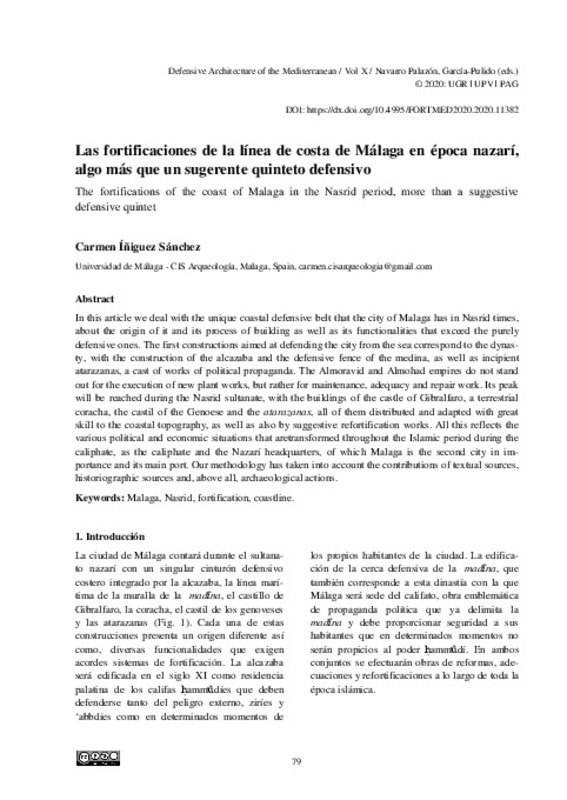JavaScript is disabled for your browser. Some features of this site may not work without it.
Buscar en RiuNet
Listar
Mi cuenta
Estadísticas
Ayuda RiuNet
Admin. UPV
Las fortificaciones de la línea de costa de Málaga en época nazarí, algo más que un sugerente quinteto defensivo
Mostrar el registro sencillo del ítem
Ficheros en el ítem
| dc.contributor.author | Íñiguez Sánchez, Carmen
|
es_ES |
| dc.coverage.spatial | east=-4.4159583; north=36.7214804; name=Calle Alcazabilla, 2, 29016 Málaga, Espanya | es_ES |
| dc.date.accessioned | 2020-07-03T09:38:38Z | |
| dc.date.available | 2020-07-03T09:38:38Z | |
| dc.date.issued | 2020-05-15 | |
| dc.identifier.isbn | 9788490488560 | |
| dc.identifier.uri | http://hdl.handle.net/10251/147365 | |
| dc.description.abstract | [EN] In this article we deal with the unique coastal defensive belt that the city of Malaga has in Nasrid times, about the origin of it and its process of building as well as its functionalities that exceed the purely defensive ones. The first constructions aimed at defending the city from the sea correspond to the dynasty, with the construction of the alcazaba and the defensive fence of the medina, as well as incipient atarazanas, a cast of works of political propaganda. The Almoravid and Almohad empires do not stand out for the execution of new plant works, but rather for maintenance, adequacy and repair work. Its peak will be reached during the Nasrid sultanate, with the buildings of the castle of Gibralfaro, a terrestrial coracha, the castil of the Genoese and the atarazanas, all of them distributed and adapted with great skill to the coastal topography, as well as also by suggestive refortification works. All this reflects the various political and economic situations that aretransformed throughout the Islamic period during the caliphate, as the caliphate and the Nazarí headquarters, of which Malaga is the second city in importance and its main port. Our methodology has taken into account the contributions of textual sources, historiographic sources and, above all, archaeological actions. | es_ES |
| dc.language | Español | es_ES |
| dc.publisher | Editorial Universitat Politècnica de València | es_ES |
| dc.rights | Reconocimiento - No comercial - Sin obra derivada (by-nc-nd) | es_ES |
| dc.subject | Fortifications | es_ES |
| dc.subject | Mediterranean | es_ES |
| dc.subject | Modern age | es_ES |
| dc.subject | Built Heritage | es_ES |
| dc.subject | Malaga | es_ES |
| dc.subject | Nasrid | es_ES |
| dc.subject | Fortification | es_ES |
| dc.subject | Coastline | es_ES |
| dc.title | Las fortificaciones de la línea de costa de Málaga en época nazarí, algo más que un sugerente quinteto defensivo | es_ES |
| dc.title.alternative | The fortifications of the coast of Malaga in the Nasrid period, more than a suggestive defensive quintet | es_ES |
| dc.type | Capítulo de libro | es_ES |
| dc.type | Comunicación en congreso | es_ES |
| dc.identifier.doi | 10.4995/FORTMED2020.2020.11382 | |
| dc.rights.accessRights | Abierto | es_ES |
| dc.description.bibliographicCitation | Íñiguez Sánchez, C. (2020). Las fortificaciones de la línea de costa de Málaga en época nazarí, algo más que un sugerente quinteto defensivo. Editorial Universitat Politècnica de València. 79-86. https://doi.org/10.4995/FORTMED2020.2020.11382 | es_ES |
| dc.description.accrualMethod | OCS | es_ES |
| dc.relation.conferencename | FORTMED2020 - Defensive Architecture of the Mediterranean | es_ES |
| dc.relation.conferencedate | Octubre 01-03,2020 | es_ES |
| dc.relation.conferenceplace | Granada, Spain | es_ES |
| dc.relation.publisherversion | http://ocs.editorial.upv.es/index.php/FORTMED/FORTMED2020/paper/view/11382 | es_ES |
| dc.description.upvformatpinicio | 79 | es_ES |
| dc.description.upvformatpfin | 86 | es_ES |
| dc.type.version | info:eu-repo/semantics/publishedVersion | es_ES |
| dc.relation.pasarela | OCS\11382 | es_ES |








